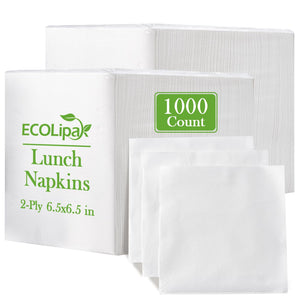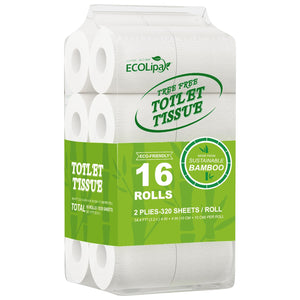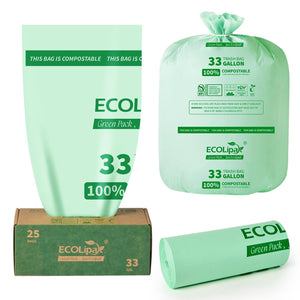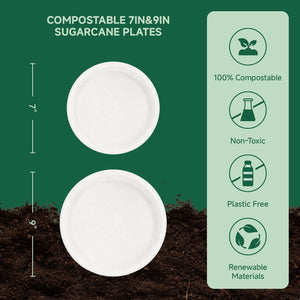I used to toss every paper napkin into my compost bin. I thought I was doing the right thing, especially since paper products make up about 23% of household waste. It wasn't until my pile became a soggy mess that I realized there was more to it.
The good news is, you can absolutely compost most napkins. This simple act reduces harmful landfill gases by over 90%. My journey to perfect composting napkins taught me the secret: knowing which ones to choose. This post shares the simple rules I learned to get it right every time.
Key Takeaways
Choose plain, unbleached napkins made from plant fibers. Avoid napkins with grease, chemicals, or bright colors.
Shred napkins into small pieces before adding them to your compost. This helps them break down faster.
Balance napkins (browns) with green materials like food scraps. Mix them deep into the compost pile.
Fix slow compost by adding air or greens. Bury food scraps deep to keep pests away. Add browns to a soggy pile.
IDENTIFYING COMPOST-SAFE NAPKINS
The first major lesson on my composting journey was learning to be a napkin detective. You need to know what’s in a napkin before you decide its fate. Some napkins are a gift to your garden, while others can introduce unwanted chemicals. Let's break down what to look for.
COMPOST-SAFE CHOICES
You can feel great about adding the right kind of napkins to your compost. These choices break down easily and enrich your soil. The key is choosing products made from natural, unprocessed materials.
So, what makes a napkin compost-safe? Look for these features:
Made from Plant Fibers: Truly compostable napkins come from nature. This includes materials like sustainably sourced wood pulp, recycled paper, fast-growing bamboo, or even upcycled sugarcane bagasse.
Unbleached or Chlorine-Free: The best options are brown or off-white napkins. These are not treated with chlorine bleach, which can harm the helpful microorganisms in your compost pile.
Free of Harmful Additives: Plain is perfect. You want napkins without synthetic fragrances, lotions, or chemical softeners.
After my soggy compost disaster, I searched for a reliable option. I needed something that was eco-friendly but also worked well for my family. That’s when I found the perfect solution: simple, white, 2-ply napkins made from premium paper fibers. They are completely BPA-free, which gives me peace of mind knowing no harmful chemicals are entering my compost. Finding them felt like a huge win. It proved you don’t have to sacrifice quality for sustainability, a feeling many people share when they switch to eco-conscious products.
Pro Tip: Look for official certifications to guide you. A BPI (Biodegradable Products Institute) certified product, for example, guarantees it will break down safely in a composting environment within 90 days and won't leave toxic residues behind. This is a great shortcut to identifying compost-safe items.
NAPKINS TO AVOID
Just as important as knowing what to add is knowing what to leave out. Tossing the wrong napkins into your bin can slow decomposition, harm your soil, and even attract pests. Here are the types of napkins you should always place in the trash.
Greasy or Oily Napkins: A little bit of food residue is fine, but napkins soaked in grease, oil, or dairy can cause foul odors and attract rodents.
Napkins Used with Chemical Cleaners: If you used a napkin to wipe up a chemical spill or cleaning spray, it must go in the trash. Those chemicals can kill the beneficial bacteria and worms working hard in your compost.
Brightly Colored or Heavily Printed Napkins: This was a surprise to me! Many decorative napkins use inks that contain heavy metals like lead and chromium. Studies have also found that certain colorants, especially in red, orange, and yellow napkins, can release toxic chemicals called PAAs. These substances have no place in the healthy soil you’re trying to create.
Chlorine-Bleached Napkins: Bright white napkins often get their color from chlorine bleach. This process creates dioxins, which are toxic pollutants.
Understanding the difference between bleaching methods is a big part of learning how to compost paper products safely. Here’s a simple breakdown:
Feature |
Unbleached Paper |
Elemental Chlorine-Free (ECF) Paper |
|---|---|---|
Process |
No chlorine is used. |
Bleached with a chlorine derivative. |
Compost Safety |
Excellent for composting. |
Can introduce trace chemicals to your pile. |
Appearance |
Natural brown or off-white. |
Appears bright white. |
Health |
Safest choice, fewer chemical residues. |
Reduced, but not zero, chemical concerns. |
Ultimately, avoiding these types is the simplest path to successful composting napkins. Stick with plain, unbleached, or certified compostable options to keep your compost pile healthy and productive.
A SIMPLE METHOD FOR COMPOSTING NAPKINS
Once you become an expert at spotting the right napkins, the next part of my journey was figuring out the best way to add them to my pile. Just tossing them on top led to them blowing away or turning into a papery crust. Through trial and error, I developed a simple four-step method. This approach ensures your napkins break down quickly and contribute to rich, healthy compost without any fuss.
STEP 1: SHRED FOR SPEED
Your first move is to tear the napkins into smaller pieces. You don't need a special shredder; ripping them by hand into strips about an inch wide works perfectly. This single action dramatically speeds up decomposition.
Why does this work so well? Think of it like this: microbes are the tiny workers in your compost pile. Giving them smaller pieces is like opening more doors for them to enter and start their job. This simple act of shredding helps in several ways:
It creates a much larger surface area for bacteria and fungi to act upon.
More access points for microbes mean the material breaks down much faster.
It prevents the napkins from clumping together into a dense, airless mat.
This is a key lesson in learning how to compost paper products effectively. A few seconds of tearing makes a huge difference.
STEP 2: MOISTEN IF NEEDED
Your compost pile needs to be damp, but not soaking wet, for the microbes to thrive. Dry paper napkins can suck moisture from the surrounding material, slowing everything down.
Before adding your shredded napkins, check the moisture level of your pile. The ideal texture is that of a wrung-out sponge. If your pile feels dry, lightly spray the napkins with water before you mix them in. If your pile is already very wet (for example, after adding a lot of fresh food scraps), you can add the dry napkins to help absorb some of that excess moisture.
Composter's Tip: Experts say the ideal moisture content for a hot, active compost pile is between 50% and 60%. The "wrung-out sponge" test is a simple and reliable way to estimate this without any special tools.
STEP 3: BALANCE BROWNS AND GREENS
Successful composting is all about balance. Your compost pile needs a healthy mix of carbon-rich "brown" materials and nitrogen-rich "green" materials. Paper napkins are an excellent source of carbon. To balance them out, you need to add greens.
The perfect recipe for fast, odor-free composting aims for a carbon-to-nitrogen (C:N) ratio of about 25:1 to 30:1. If you have too much nitrogen (greens), your pile can get slimy and smell like ammonia. If you have too much carbon (browns), the composting process will be very slow.
Every time you add a handful of shredded napkins (browns), try to add a similar amount of greens. Some great "green" materials include:
🌱 Grass clippings
🌱 Kitchen scraps like fruit and vegetable peels
🌱 Coffee grounds and used tea bags
🌱 Plant trimmings from your garden
This simple act of balancing is the secret to creating a happy, healthy, and hard-working compost pile.
STEP 4: MIX IT IN DEEP
Finally, don't just lay the napkins on top of your pile. Use a pitchfork or a small garden trowel to mix them into the center. Burying them at least 6-8 inches deep is a crucial final step.
This accomplishes two important things. First, it puts the napkins in the hottest part of the pile, where microbial activity is highest, accelerating the composting process. Second, it keeps them covered, which prevents them from drying out or blowing away and makes them less attractive to pests.
Regularly turning your pile is like giving it a breath of fresh air. It distributes moisture and heat evenly and replenishes the oxygen that your aerobic microbes need to work efficiently. By mixing your materials well, you ensure that everything breaks down uniformly, turning your waste into valuable "black gold" for your garden much faster.
TROUBLESHOOTING COMMON ISSUES
Even with the best intentions, your composting journey might hit a few bumps. My pile certainly did! Don't worry if things seem off. Most problems are easy to fix once you know what to look for. Here are the solutions to the most common issues I encountered, including those related to composting napkins.
SLOW DECOMPOSITION
You might notice your pile isn't breaking down as quickly as you'd like. This is often a sign that your microbes need a little help. A slow pile usually points to one of three things:
Lack of Air: If materials become matted down, air cannot circulate. This slows down the helpful aerobic microbes.
Imbalanced Ratio: Your pile might have too many "browns" (carbon) and not enough "greens" (nitrogen). Microbes need a balanced diet to work efficiently.
Large Materials: Big chunks of waste take much longer to decompose. Remember, microbes take small bites!
If your pile has stalled, try turning it with a pitchfork to add air. You can also add more nitrogen-rich "greens" like fresh grass clippings or coffee grounds from a local shop to restart the process.
UNWANTED PESTS
Nothing is more discouraging than finding pests in your compost. Rodents, flies, and ants are often attracted to improperly managed piles. The main culprit is usually exposed food. Napkins used to wipe up greasy or oily foods are especially tempting for animals like rats and raccoons.
To keep pests away, always bury new food scraps at least 12 inches deep under a layer of "brown" material. This simple step hides the smell and makes your pile uninviting. Also, make sure your compost bin has a tight-fitting lid to block access.
A SOGGY PILE
If your compost pile smells like rotten eggs or sewage, it has likely become too wet. This foul odor is a clear sign that your pile has gone anaerobic, meaning it lacks oxygen. You might also see a brown liquid leaking from the bottom. This happens when you have too many "green" materials or after heavy rain.
To fix a soggy pile, you need to add more carbon-rich "browns" to soak up the extra moisture. Turn the pile thoroughly while mixing in materials like:
Shredded cardboard or paper egg cartons
Dry, fallen leaves from your yard
Clean sawdust from untreated wood
These materials absorb water and create air pockets, helping your pile breathe again.
My journey taught me one simple rule: plain, unbleached napkins like those from Ecolipak are a compost pile's best friend, while greasy or chemical-laden ones are not. You can avoid common pitfalls by following the simple steps of shredding, balancing, and burying. This makes the process of composting napkins easy and effective.
Start today! Turning your napkin waste into garden gold is one of the easiest steps on your sustainability journey. Go green with your pack! 🌱
FAQ
### Can I compost napkins with food on them?
Yes, you can compost napkins with small food scraps. Avoid adding napkins soaked in grease, oil, or dairy. These items create bad smells and attract unwanted pests to your pile. Stick to napkins with plant-based food residue for the best results.
### How long does it take for napkins to compost?
Napkins can break down in a few weeks to a few months. The speed depends on your pile's conditions. Shredding the napkins, keeping the pile moist, and turning it regularly will make them disappear much faster into your finished compost.
### Do I need a special bin to compost napkins?
No, you do not need a special bin. You can add compost-safe napkins to any composting system. This includes simple backyard piles, enclosed tumblers, or worm bins. Just be sure to mix them in well with your other materials.
### Why are plain napkins better for my compost?
Plain, uncolored napkins are safest for your soil. Brightly colored or printed napkins may contain inks with heavy metals. Bleached white napkins can also add unwanted chemicals. Choosing plain options ensures you create clean, healthy compost for your garden. 🌱









